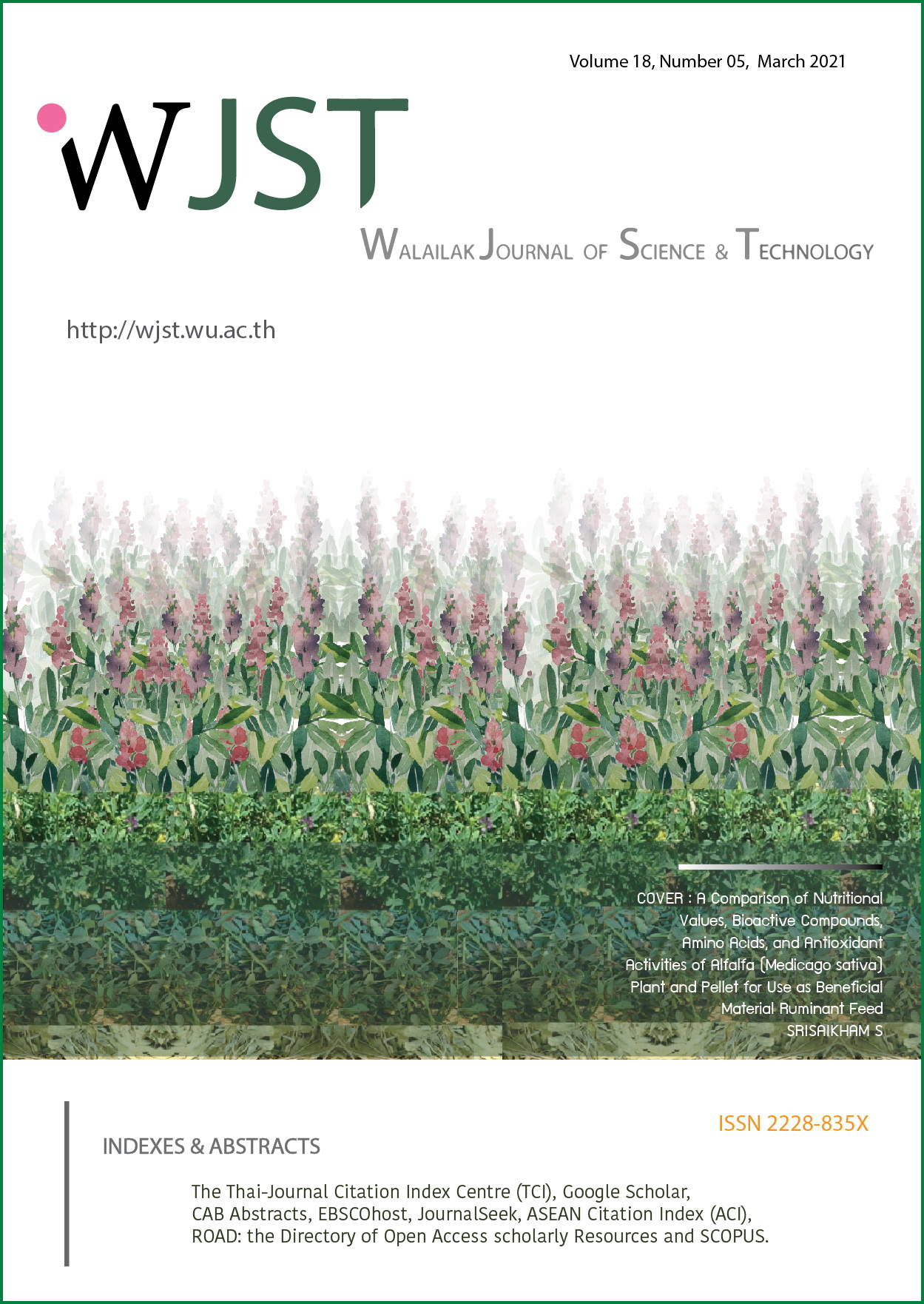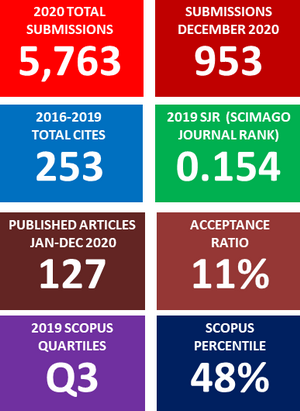Extraction of Bio Polymers from Crustacean Shells and its Application in Refinery Wastewater Treatment
DOI:
https://doi.org/10.48048/wjst.2021.11543Keywords:
Biochemical oxygen demand, Chitosan, Crab shell, Refinery effluent, Thermo gravimetric analysisAbstract
The fisheries sector is one of the most ancient and important sectors in the world and plays a significant role in providing the nutrition and socio-economic development of the country. The fish processing industry produces huge quantities of wastewater, encompassing significant amounts of contaminants in the form of soluble, colloidal, and particulate matters. The disposal of shellfish waste is a serious issue, and the effluents discharged from seafood-processing plants contain high amounts of Chemical Oxygen Demand (COD), Biochemical Oxygen Demand (BOD), dissolved solids, suspended solids, and turbidity. The existing waste management system lacks a cost-effective and environmentally friendly method. The current research focus on the extraction of a biopolymer chitosan from crab shells by ecofriendly methods and its application in refinery wastewater treatment. The chemical structure and crystallinity of the extracted chitosan was confirmed by Fourier Transform Infrared Spectroscopy (FTIR) and X-Ray Diffraction (XRD) analyses. Surface morphology and elemental composition were determined using Scanning Electron Microscopy (SEM), and Energy-Dispersive X-Ray Analysis (EDX). Thermal properties were detected using Thermo Gravimetric Analysis (TGA). The extracted chitosan was successfully employed in the batch treatment of refinery effluent by varying the experimental parameters (refinery effluent solution pH, contact time, dosage of chitosan, and stirring speed) and the optimizations of the processing conditions were established.
Downloads
Metrics
References
RM Younus. Chitin and Chitosan preparation from marine sources: Structure, properties and applications. Mar. Drugs 2015; 13, 1133-74.
E Bulut, I Sargin, O Arslan, M Odabasi, B Akyuz and M Kaya. In situ chitin isolation from body parts of a centipede and lysozyme adsorption studies. Mater. Sci. Eng. C 2017; 70, 552-63.
CC Chen, YR Wang, YN Yang, MZ Pan, T Ye and DG Li. High strength gelatin-based nano composites reinforced by surface-deacetylated chitin nano fiber networks. Carbohydr. Polym. 2018; 195, 387-92.
Y Huang, M Yao, X Zheng, X Liang, X Su, Y Zhang, A Lu and L Zhang. Effects of chitin whiskers on physical properties and osteoblast culture of alginate based nano composite hydrogels. Biomacromolecules 2015; 16, 3499-507.
RA Kumar, A Sivashanmugam, S Deepthi, S Iseki, KP Chennazhi, SV Nair and R Jayakumar. Injectable Chitin-poly (Ɛ-Caprolactone)/nano hydroxyapatite composite microgels prepared by simple regeneration technique for bone tissue engineering. ACS Appl. Mater. Interfaces 2015; 7, 9399-409.
S Hajji, O Ghorbelbellaaj, I Younes, K Jellouli and M Nasri. Chitin extraction from crab shells by Bacillus bacteria: Biological activities of fermented crab supernatants. Int. J. Biol. Macromol. 2015; 79, 167-73.
P Zhu, Z Gu, S Hong and H Lian. One-pot production of chitin with high purity from lobster shells using choline chloride-malonic acid deep eutectic solvent. Carbohydr. Polym. 2017; 177, 217-23.
R Zhu, C Zhang, Y Liu, ZQ Yuan, WL Chen, SD Yang, JZ Li, WJ Zhu, XF Zhou, BG You and XN Zhang. CD147 monoclonal antibody mediated by chitosan nanoparticles loaded with α-hederin enhances antineoplastic activity and cellular uptake in liver cancer cells. Sci. Rep. 2016; 5, 1-11.
H Li and LH Greene. Sequence and structural analysis of the chitinase insertion domain reveals two conserved motifs involved in chitin-binding. PLoS One 2010; 1, 1-11.
N Yaghobi and H Mirzadeh. Enhancement of chitin’s degree of deacetylation by multistage alkali treatments. Iran. Polym. J. 2004; 13, 131-6.
OBS Hasan, S Satheesh and MA Ba-akdah. Extraction of chitin from the shell wastes of two shrimp species Fenneropenaeus semisulcatus and Fenneropenaeus indicus using microorganisms. J. Aqua. Food Prod. Tech. 2016; 26, 390-405.
J Bratby. Coagulation and flocculation in water and wastewater treatment. 2nd eds. IWA Publishing, 2007, p. 1-450.
VR Giri-Dev, R Neelakandan, S Sudha, OL Shamugasundram and RN Nadaraj. Chitosan: A polymer with wider applications. Text. Magaz. 2005; 46, 83-6.
KVH Prashanth and RN Tharanathan. Chitin/Chitosan: Modifications and their unlimited application- an overview. Trends Food Sci. Technol. 2007; 18, 117-31.
N Kashyap, N Kumar and MNVR Kumar. Hydrogels for pharmaceutical and biomedical applications. Crit. Rev. Ther.Drug. Carrier Sys. 2005; 22, 104-50.
B Krajewska. Membrane-based processes performed with use of Chitin/Chitosan materials. Sep. Purif. Technol. 2005; 41, 305-12.
F Renault, B Sancey, PM Badot and G Crini. Chitosan for coagulation/flocculation processes-an eco-friendly approach. Eur. Polym. J. 2009; 45, 1337-48.
C Dong, W Chen and C Liu. Flocculation of algal cells by amphoteric chitosan-based flocculant. Bioresour. Technol. 2014; 170, 239-47.
MT Yen, JH Yang and JL Mau. Physico chemical characterization of chitin and chitosan from crab shells. Carbohydr. Polym. 2009; 75, 15-21.
RAA Muzzarelli, P Morganti and G Morganti. Chitin nanofibrils/Chitosan glycolate composites as wound medicaments. Carbohydr. Polym. 2007; 70, 274-84.
M Rinaudo. Chitin and Chitosan: Properties and applications. Prog. Polym. Sci. 2006; 31, 603-63.
Downloads
Published
How to Cite
Issue
Section
License
Copyright (c) 2020 Walailak University

This work is licensed under a Creative Commons Attribution-NonCommercial-NoDerivatives 4.0 International License.













